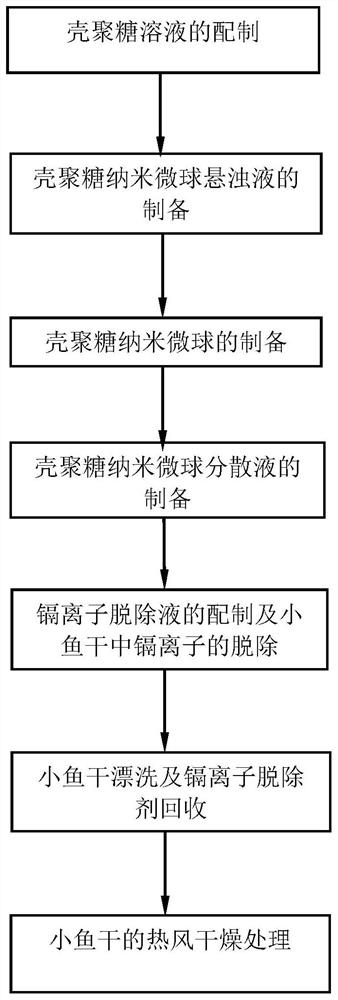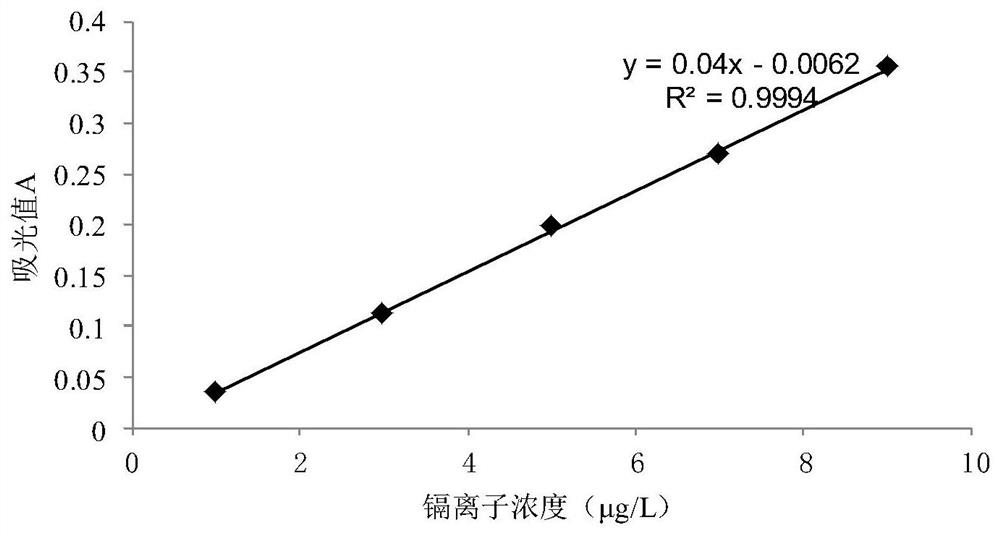A method for removing cadmium from dried small fish by using chitosan nano-microspheres
A technology of chitosan nano and small dried fish, which is applied in the field of food processing, can solve the problems of increasing cancer risk and toxicity, and achieve the effects of improving quality and edibility, improving adsorption efficiency, broad market prospects and application value
- Summary
- Abstract
- Description
- Claims
- Application Information
AI Technical Summary
Problems solved by technology
Method used
Image
Examples
Embodiment 1
[0033] (1) Preparation of chitosan nano-microspheres: Dissolve weighed chitosan in 1% dilute acetic acid solution, prepare 2 g / L chitosan solution and filter out impurities. Slowly add 1g / L sodium tripolyphosphate solution dropwise (2-4ml / min) to the chitosan solution, stir until the solution becomes a milky suspension, and the final addition ratio is 4:1 (v:v=chitosan Solution: sodium tripolyphosphate solution) or so. Concentrate the prepared chitosan nano-microsphere suspension under reduced pressure, and then dry it in a vacuum oven at 50° C. for 22 hours until it becomes solid.
[0034] (2) Preparation of removal solution: prepare sodium dihydrogen phosphate ~ citric acid buffer solution, pH = 5.4, mix the buffer solution with glycerol at a volume ratio of 2:1 to obtain a glycerol buffer solution, and then add chitosan nano-microspheres Add 1.5% to glycerol buffer to prepare chitosan nanosphere dispersion.
[0035] (3) Removal of cadmium ions in C. kangshii male: adjust ...
Embodiment 2
[0040] (1) Preparation of chitosan nano-microspheres: Dissolve weighed chitosan in 1% dilute acetic acid solution, prepare 1.5 g / L chitosan solution and filter out impurities. Slowly add 0.8g / L sodium tripolyphosphate solution dropwise (2-4ml / min) to the chitosan solution, stir until the solution becomes a milky suspension, and the final addition ratio is 4:1 (v:v=chitosan Sugar solution: sodium tripolyphosphate solution) or so. Concentrate the prepared chitosan nano-microsphere suspension under reduced pressure, and then dry it in a vacuum oven at 50° C. for 22 hours until it becomes solid.
[0041] (2) Preparation of removal solution: prepare sodium dihydrogen phosphate-citric acid buffer solution, pH=4.5, mix the buffer solution and glycerol at a volume ratio of 3:1 to obtain a glycerol buffer solution, and then add chitosan nano-microspheres Add 2% to glycerol buffer to prepare chitosan nanosphere dispersion.
[0042] (3) Removal of cadmium ions in the male fish C. kangs...
Embodiment 3
[0044] (1) Preparation of chitosan nano-microspheres: Dissolve weighed chitosan in 1% dilute acetic acid solution to prepare 2.5 g / L chitosan solution and filter out impurities. Slowly add 1.5g / L sodium tripolyphosphate solution dropwise (2-4ml / min) to the chitosan solution, stir until the solution becomes a milky suspension, and the final addition ratio is 5:1 (v:v=chitosan Sugar solution: sodium tripolyphosphate solution) or so. Concentrate the prepared chitosan nano-microsphere suspension under reduced pressure, and then dry it in a vacuum oven at 50° C. for 22 hours until it becomes solid.
[0045] (2) Preparation of removal solution: prepare sodium dihydrogen phosphate-citric acid buffer solution, pH=6.0, mix the buffer solution and glycerol in a volume ratio of 3:2 to obtain a glycerol buffer solution, and then add chitosan nanospheres Add 1% to glycerol buffer to prepare chitosan nanosphere dispersion.
[0046] (3) Removal of cadmium ions in the male fish C. kangshii:...
PUM
 Login to View More
Login to View More Abstract
Description
Claims
Application Information
 Login to View More
Login to View More - R&D Engineer
- R&D Manager
- IP Professional
- Industry Leading Data Capabilities
- Powerful AI technology
- Patent DNA Extraction
Browse by: Latest US Patents, China's latest patents, Technical Efficacy Thesaurus, Application Domain, Technology Topic, Popular Technical Reports.
© 2024 PatSnap. All rights reserved.Legal|Privacy policy|Modern Slavery Act Transparency Statement|Sitemap|About US| Contact US: help@patsnap.com










